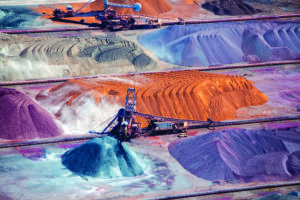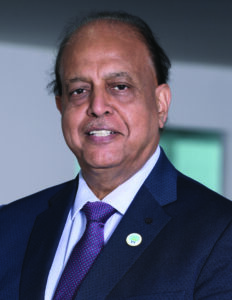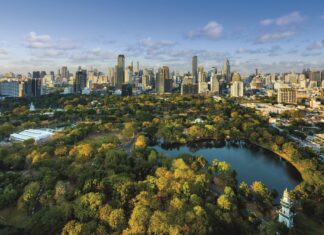With the company behind them celebrating its 100th anniversary, two Indian projects highlight the opportunities around industrial applications of water reclamation and reuse. J Lahnsteiner and BK Kumaran outline the projects.
Established in August 1924, WABAG (now VA Tech WABAG) has a rich history that spans more than a century, offering a range of sustainable water technology solutions focused on conservation, optimisation, recycling and the reuse of resources.
As it celebrates its centenary (see panel, ‘Celebrating a century of environmental stewardship’, on page 32), the company is delivering projects that highlight the important role of industry in exploiting the potential of water reclamation and reuse, and the technology options for achieving this. One of the latest projects is a water reclamation and reuse facility in Ghaziabad, India.
Ghaziabad water reclamation and reuse project
The 40,000 m3/d Tertiary Treatment Reverse Osmosis (TTRO) plant in Ghaziabad, Uttar Pradesh, is a landmark initiative under the Hybrid Annuity Model, embodying a circular economy approach to wastewater management. A testament to WABAG’s ‘Manufactured Water’ concept, the plant provides industries with a viable, reliable, and sustainable water source by treating municipal used water. Using ultrafiltration (UF) and reverse osmosis (RO), the facility produces high-quality non-potable water, supplying nearly 1500 industries in the Sahibabad Industrial Estate through a dedicated transmission and distribution network.
By reducing dependence on groundwater, the plant conserves more than 14 million m3 of freshwater annually, directly addressing the city’s severe water stress.
Classified as a ‘dark zone’ by the National Green Tribunal (NGT), the region has faced declining groundwater levels, making this initiative crucial for long-term sustainability. With an 80% offtake guarantee, the project also ensures financial viability while offering industries a cost-effective and reliable alternative.
The TTRO plant reduces discharge of sewage into the Hindon river and smart water systems enable real time monitoring, optimising consumption and minimising wastage.

Environmentally and financially sustainable
The Ghaziabad TTRO contract guarantees a 15-year water supply for industries, demonstrating resilience against water scarcity. Operating under a zero-extraction policy, it ensures compliance with local and federal regulations. And from an economic point of view, the plant offers water at a cheaper price (INR 41/m3 which is equivalent to €0.45/m3) than comparable facilities, making it financially attractive for industries. In addition, the mandated use of TTRO-treated water aligns with national and global water security goals, promoting awareness of sustainable water usage and setting a precedent for cities worldwide looking to embrace sustainable, technology-driven water management solutions.
Another of WABAG’s showcase projects is the largest centralised zero liquid discharge (CZLD) plant in the Indian steel industry. This project sets a significant precedent in reducing the sector’s reliance on freshwater sources.
Nagarnar Centralised Zero Liquid Discharge Project
The 4320 m3/day CZLD plant at Nagarnar, Chhattisgarh, is a benchmark initiative in India’s steel industry and a major step towards sustainable water management. Developed by WABAG for NMDC (formerly the National Mineral Development Corporation), with Mecon India as the project consultant, the plant enables comprehensive recycling of industrial wastewater through an advanced treatment process, reinforcing WABAG’s circular economy approach.
The facility treats effluent from 15 different sources within NMDC’s 3 MTPA (million tonnes per annum) integrated steel plant, including five high total dissolved solids streams and complex pollutants such as cyanides, thiocyanates, oil and grease, and organic compounds. Using a combination of membrane-based treatment and multiple effect evaporation (MEE), the plant achieves an impressive 90% water recovery rate. The recovered water is reused within the plant’s cooling system, significantly reducing reliance on freshwater sources.
Additionally, the MEE system crystallises salts from reject streams, minimising waste and enhancing process efficiency. This closed-loop solution eliminates discharge to the environment and ensures compliance with increasingly stringent environmental norms.
Environmentally and financially sustainable
Commissioned in 2023, the facility faced considerable challenges, including the treatment of effluent streams with thiocyanate concentrations of around 600 ppm and chemical oxygen demand (COD) levels close to 800 ppm – among the most difficult to manage during commissioning. However, with a robust treatment train comprising a high-rate solid contact clarifier, a dual media filter, an activated carbon filter, UV disinfection, UF, RO, and MEE, the plant delivers consistent performance.
With rising water scarcity and growing regulatory pressure, the CZLD plant ensures uninterrupted steel plant operations under a zero-discharge policy. It serves as a scalable model for similar industrial ecosystems looking to enhance water efficiency, minimise environmental impact, and embrace a future-ready, sustainable approach to resource management.
The authors: Dr Josef Lahnsteiner is Director of Technology and R&D, WABAG Group, and BK Kumaran is Head of the Technical Support Team and Commissioning at VA Tech WABAG

Nagarnar, Chhattisgarh
Celebrating a century of environmental stewardship

“For 100 years, WABAG (now VA Tech WABAG) has been a global force in water sustainability, delivering solutions that secure resources, protect ecosystems, and foster economic growth. This journey has been shaped by a deep commitment to environmental stewardship, ensuring that water remains accessible, reusable, and responsibly managed.
From building water and wastewater infrastructure that touches millions of lives daily, to enabling industries and cities to thrive, WABAG has played a pivotal role in addressing water and sanitation challenges. This legacy has left a lasting impact on communities worldwide, ensuring access to clean water and strengthening water security.
At WABAG, we believe water is too precious to be used just once. This philosophy has driven us to champion the ‘Manufactured Water’ concept – turning seawater and wastewater (used water) into viable and sustainable resources.
Our plants operate on a resource recovery model, ensuring that used water is no longer a liability, but a valuable asset. By integrating advanced desalination, used water treatment and water reuse technologies, we reduce freshwater dependency, conserve groundwater, and minimise environmental impact.
As we look ahead, our commitment to pioneering innovation and sustainable water solutions remains firm. With more than 6500 plants across 25 countries, we continue to push boundaries in ‘manufactured water’, circular economy-based resource recovery, energy efficient technologies, and climate resilient infrastructure. Our mission is clear – to create a water-secure world, where every drop is valued, treated, and reused responsibly.
For WABAG, the past century has been about preserving resources, protecting the environment and powering economies. The next century will be about amplifying this impact, continuing to innovate, lead and build a sustainable future for generations to come.”
Rajiv Mittal, Chairman and Managing Director, VA Tech WABAG








